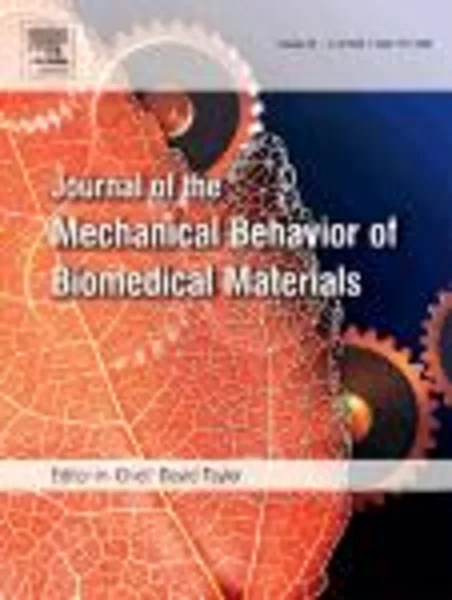-
impact of thermomechanical texture on the superelastic response of nitinol implants
جزئیات بیشتر مقاله- تاریخ ارائه: 1394/01/01
- تاریخ انتشار در تی پی بین: 1394/01/01
- تعداد بازدید: 827
- تعداد پرسش و پاسخ ها: 0
- شماره تماس دبیرخانه رویداد: -
the phenomenon of superelasticity in near-equiatomic niti, which originates from a first-order martensitic phase transition, is exploited in an increasing number of biomedical devices, most importantly endovascular stents. these stents are often manufactured from microtubing, which is shown to be highly textured crystallographically. synchrotron x-ray microdiffraction provided microstructural, phase, and strain analysis from nitinol tube sections that were deformed in situ along longitudinal, circumferential, and transverse orientations. we show that the large variation in the superelastic response of niti in these three tube directions is strongly influenced by the path that the martensitic transformation follows through the microstructure. specifically, in severely worked niti, bands of 〈100〉 grains occur whose orientation deviates markedly from the surrounding matrix; these bands have an unusually large impact on the initiation and the propagation of martensite, and hence on the mechanical response. understanding the impact of these local microstructural effects on global mechanical response, as shown here, leads to a much fuller understanding of the causes of deviation of the mechanical response from predictions and unforeseen fracture in niti biomedical devices.
مقالات جدیدترین رویدادها
-
استفاده از تحلیل اهمیت-عملکرد در ارائه الگوی مدیریت خلاقیت سازمانی و ارائه راهکار جهت بهبود
-
بررسی تاثیر ارزش وجوه نقد مازاد بر ساختار سرمایه شرکت های پذیرفته شده در بورس اوراق بهادار تهران
-
بررسی تأثیر سطح افشای ریسک بر قرارداد بدهی شرکت های پذیرفته شده در بورس اوراق بهادار تهران
-
بررسی تأثیر رتبه بندی اعتباری مبتنی بر مدل امتیاز بازار نوظهور بر نقد شوندگی سهام با تأکید بر خصوصی سازی شرکت ها
-
تأثیر آمیخته بازاریابی پوشاک ایرانی بر تصویر ذهنی مشتری پوشاک ایرانی (هاکوپیان)
-
اهمیت استراتژی مدیریت اکوسیستم در منطقه گردشگری دریای عمان
-
بررسی منشا گارنت های موجود در گرانودیوریت های منطقه دهنو، شمال غرب مشهد، استان خراسان رضوی
-
نقش سرمایه فکری در بهبود فرآیندهای اقتصادی
-
مقایسه تأثیر لیزر کم توان و اولتراسوند در مبتلایان به سندرم درد عضلانی- فاشیایی
-
effect of (zn(oh)2)3(znso4)(h2o)5 on the performance of ru–zn catalyst for benzene selective hydrogenation to cyclohexene
مقالات جدیدترین ژورنال ها
-
مدیریت و بررسی افسردگی دانش آموزان دختر مقطع متوسطه دوم در دروان کرونا در شهرستان دزفول
-
مدیریت و بررسی خرد سیاسی در اندیشه ی فردوسی در ادب ایران
-
واکاوی و مدیریت توصیفی قلمدان(جاکلیدی)ضریح در موزه آستان قدس رضوی
-
بررسی تاثیر خلاقیت، دانش و انگیزه کارکنان بر پیشنهادات نوآورانه کارکنان ( مورد مطالعه: هتل های 3 و 4 ستاره استان کرمان)
-
بررسی تاثیر کیفیت سیستم های اطلاعاتی بر تصمیم گیری موفق در شرکتهای تولیدی استان اصفهان (مورد مطالعه: مدیران شرکتهای تولیدی استان اصفهان)
-
مطالعه تاثیر بانکداری الکترونیکی بر نیت رفتاری مصرف کنندگان در صنعت بانکداری
-
بررسی درآمدهای مالیاتی خراسان شمالی و ارتباط بین درآمد مصوب شده و عملکرد از سال 90-96
-
نقش توان مندی مدیران در کشف کلاه برداری گزارشگری مالی با در نظر گرفتن حضور و نفوذ صاحب منصبان دولتی در ارکان اداره شرکت ها با تعیین درجه سیاست دولتی بر اساس شاخص sa
-
surface adsorption of carbon monoxide and hydrogen gases mixed with boron nitride (7 ,7) nanotubes by monte carlo method
-
the effects of employees’ integrity, responsibility, compassion and forgiveness on corporate social responsibility in iranian private sector in east and west of azerbaijan in iran




سوال خود را در مورد این مقاله مطرح نمایید :